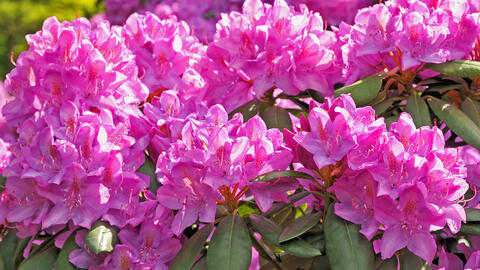How to Fertilize Your Rhododendrons
Rhododendrons are very sensitive to chalky soils and therefore cannot tolerate all fertilizers. Find out when and how to fertilize the flowering shrubs and what with.

With the right fertilizer, rhododendrons display an abundance of stunning flowers in spring
Rhododendrons impress in many gardens in spring with their exuberant flowering. Unlike many other species from the heather family, the evergreen shrub likes to be fed: the plant needs to be fertilized regularly so that it produces plenty of flower buds.
Rhododendron breeder Holger Hachmann from the nursery of the same name recommends fertilizing newly planted rhododendrons in March or April. Planting in fall is not advisable in cold regions due to the risk of winter damage, but if doing so fertilization should also be left until spring. The right amount for plants that are 12 to 24 inches in height is 1.17 to 1.76 ounces per square yard of a long-term fertilizer such as Floranid Permanent or a special fertilizer like Osmocote Rhododendron Fertilizer. You should also add approximately 0.88 ounces of horn shavings per square yard.
Coffee grounds have also proven to be an excellent organic fertilizer for Rhododendrons. They contain – albeit in smaller quantities – all the vital nutrients, make the soil slightly more acidic and enrich it with humus. This makes it very suitable for the lime-sensitive and humus-loving rhododendron. Because of the low concentration of organically bound nutrients, you can also use coffee grounds alongside other fertilizers without having to reduce their quantities. A mixture of coffee grounds and horn meal is also highly recommended. Sprinkle the coffee grounds and work into the soil just below the surface like any other organic fertilizer, so that they decompose as quickly as possible.
For well-established Rhododendrons that are around 28 to 47 inches tall, scatter around 3.17 ounces of long-term fertilizer across the outer third of the root crown and 1.76 to 2.46 ounces of horn shavings on the ground. This should also be done in March or April, and in dry weather conditions. For older Rhododendrons, experts recommend up to 4.23 ounces of long-term fertilizer and 1.76 to 2.46 ounces of horn shavings.
The fertilizer recommendations apply only to the large-leaved species. Small-leaved Rhododendrons, dwarfs and Japanese Azaleas only need half of the amount specified. Dark green, dense foliage and an abundance of buds are the signs of a well-nourished rhododendron.

If necessary, plants can be fertilized again up until the end of June – with either Blaukorn Entec or with an organic product, such as Oscorna. However, the amount should not exceed 0.88 ounces per square yard. If you are unsure whether a fertilizer is suitable for Rhododendrons, you should check the label first: you should never use products that contain lime, because the plants are very sensitive to this nutrient. If you want to play it safe, purchase a special Rhododendron fertilizer at a garden center.
By the way, if the roots of your Rhododendron are covered with mulch, you should carefully remove this from the outer root crown and then distribute the fertilizer over the soil. If it lies on the mulch layer, it decomposes faster and a large proportion of the nutrients are absorbed.



